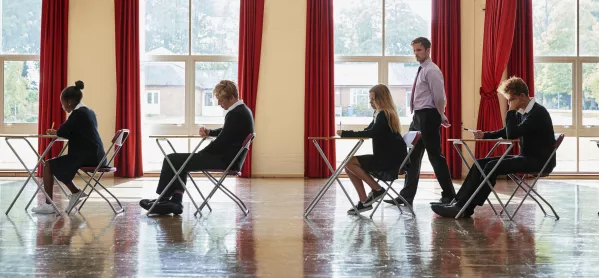- Home
- GCSE and A levels: The 7 rules for autumn exam ‘resits’
GCSE and A levels: The 7 rules for autumn exam ‘resits’

The Department for Education has released new guidance on how schools can manage the autumn series of GCSEs and A-level resit exams safely.
Here are the seven tips that schools must follow to limit the spread of coronavirus:
GCSEs 2020: Autumn exam timetable
Related: GCSE exams could be held in public buildings in 2021
GCSEs 2021: Ofqual admits to ‘issues’ with online exams
1. Follow Test and Trace
Schools and colleges will need to collect and keep contact information for candidates and exam invigilators so it can be shared with NHS Test and Trace if necessary.
The DfE says this is particularly important for external visitors such as non-school staff who might be assisting with exams, or candidates who are not on the school roll.
“Every exam will have a seating plan, so you can add the names of the invigilators and cross reference them to the contact details you hold for candidates and invigilators,” the guidance says.
2. Keep candidates separate from other students
When candidates are arriving before the start of an exam, they will need to be kept separate from other students arriving at school.
“You should identify a location where candidates will wait before the exam that can support social distancing between group ‘bubbles’ as well as between on-roll and off-roll candidates,” the guidance says.
Any candidates arriving late to the exam must observe social distancing measures, and schools and colleges must have a plan for how to manage candidates leaving the exam room, or site, especially as exams may finish at different times. Schools and colleges will also need to take candidates who need extra time into account here.
These measures also apply where other sites are being used as exam centres - students will need to be kept separate from members of the public as they arrive.
3. Keep exam halls clean
“Exam rooms should be kept clean. Frequently touched surfaces (door handles, individual desks and so on) should be cleaned after every exam with the usual cleaning products, including the backs of chairs where candidates may pull chairs out to sit,” the guidance says.
However, rooms do not need to be kept empty between exams providing they are cleaned properly each time.
4. Desks must not be face to face
The guidance says that desks must not be set up face to face, and that for GCSE and A-level exams the minimum distance between candidates’ chairs in all directions needs to be 1.25 metres - the minimum that must be maintained for students in a group bubble.
“All other candidates, whether in different group bubbles, private candidates or those returning to school or college to take exams, should be seated two metres apart from each other. These candidates can be seated in the same room,” the guidance says.
It says there is “no overall limit” on the number of candidates who can sit in a room as long as the desks are correctly spaced.
Schools and colleges should maximise ventilation wherever possible through opening windows and propping open doors, with the exception of fire doors, where safe to do so.
“Invigilators may walk up and down aisles between desks, but there must also be points in the room where an invigilator can stand at least two metres from the nearest desks and see all the candidates in the room,” the guidance states.
5. No need to wear face coverings
Candidates and invigilators can wear face coverings if they wish, but do not need to.
But “candidates and invigilators should wear face coverings in communal areas if the exam centre is in an area of local intervention, or if you have chosen to use face coverings in communal areas,” it adds.
And staff and students should follow the requirements for wearing face masks on public transport when travelling to and from exams.
6. Invigilators must minimise contact with other staff
Invigilators can move between different schools and colleges but should minimise contact with other staff, and schools should advise them how to do so.
“Before the exams, you will need to tell invigilators what they need to do to minimise contact and maintain as much distance as possible from other staff,” the guidance says.
It adds that invigilators do not need to wear gloves when collecting exam scripts from candidates.
7. Stand alongside candidates rather than facing them
“You should advise invigilators and other staff to stand alongside candidates when interacting with them, rather than face to face,” the guidance says.
It adds that for encounters of over 15 minutes, for example when scribes are supporting candidates, staff should maintain a 2 metre distance where possible, for example through using a different room.
“If staff cannot maintain a 2 metre distance, they should avoid close face to face contact and minimise time spent within 1 metre of others. These arrangements may not be possible when working with some candidates who have complex needs, in which case these candidates’ educational support should be provided as normal during exams,” it adds.
“If candidates need to leave the exam room and need to be accompanied for more than 15 minutes, staff should maintain a 2 metre distance where possible. If this is not possible, staff should take mitigating measures, such as standing alongside the candidate and considering using a face covering.”
Keep reading for just £1 per month
You've reached your limit of free articles this month. Subscribe for £1 per month for three months and get:
- Unlimited access to all Tes magazine content
- Exclusive subscriber-only stories
- Award-winning email newsletters



